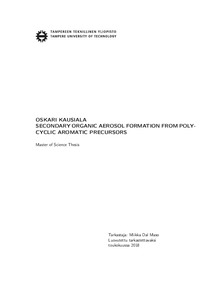Secondary Organic Aerosol Formation From Polycyclic Aromatic Precursors
Kausiala, Oskari Tapio (2018)
Kausiala, Oskari Tapio
2018
Teknis-luonnontieteellinen
Teknis-luonnontieteellinen tiedekunta - Faculty of Natural Sciences
This publication is copyrighted. You may download, display and print it for Your own personal use. Commercial use is prohibited.
Hyväksymispäivämäärä
2018-06-06
Julkaisun pysyvä osoite on
https://urn.fi/URN:NBN:fi:tty-201805081627
https://urn.fi/URN:NBN:fi:tty-201805081627
Tiivistelmä
Polycyclic aromatic hydrocarbons (PAHs) are organic compounds that are emitted into the atmosphere mainly through incomplete combustion of fossil fuels and biomass. The lifecycle of PAHs especially in urban atmosphere is of great interest due to their toxicity and secondary aerosol formation potential.
In this thesis, the oxidation reactions and new particle formation potential of the structurally simplest polycyclic aromatic hydrocarbon – naphthalene – were studied. Literature survey was made on the OH initiated oxidation reaction mechanisms of naphthalene, as well as its’ ability to produce secondary organic aerosol. Two laboratory experiments were carried out in order to study the subject.
The aim of the first experiment was to qualitatively characterize some of the oxidation products. This was done by oxidizing naphthalene in a flow tube and measuring the products with a chemical ionization mass spectrometer. In the second experiment, a large concentration of the oxidation products was generated in TSAR, while being monitored with both particle instrumentation (PSM and SMPS) as well as a mass spectrometer.
The results show that extremely low-volatility organic compounds are formed rapidly in the OH initiated oxidation of naphthalene. The oxidation products readily transform into the particle phase to form particles in the size scale of just a few nanometers. Oligomeric species were observed in the mass spectrum, and the reaction pathway leading to their formation is suggested based on the existing literature.
In this thesis, the oxidation reactions and new particle formation potential of the structurally simplest polycyclic aromatic hydrocarbon – naphthalene – were studied. Literature survey was made on the OH initiated oxidation reaction mechanisms of naphthalene, as well as its’ ability to produce secondary organic aerosol. Two laboratory experiments were carried out in order to study the subject.
The aim of the first experiment was to qualitatively characterize some of the oxidation products. This was done by oxidizing naphthalene in a flow tube and measuring the products with a chemical ionization mass spectrometer. In the second experiment, a large concentration of the oxidation products was generated in TSAR, while being monitored with both particle instrumentation (PSM and SMPS) as well as a mass spectrometer.
The results show that extremely low-volatility organic compounds are formed rapidly in the OH initiated oxidation of naphthalene. The oxidation products readily transform into the particle phase to form particles in the size scale of just a few nanometers. Oligomeric species were observed in the mass spectrum, and the reaction pathway leading to their formation is suggested based on the existing literature.
